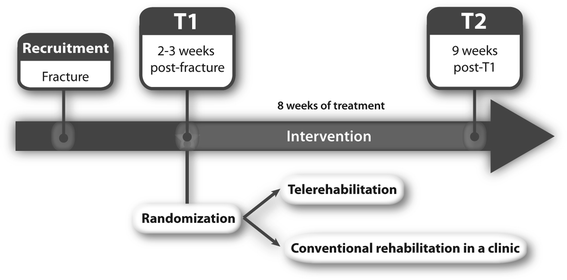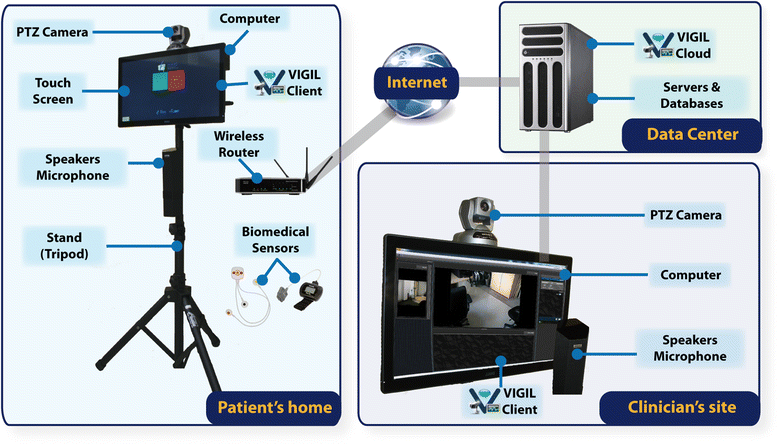Is an in-home telerehabilitation program for people with proximal humerus fracture as effective as a conventional face-to face rehabilitation program? A study protocol for a noninferiority randomized clinical trial
- PMID: 27570627
- PMCID: PMC5000429
- DOI: 10.1186/s13102-016-0051-z
Is an in-home telerehabilitation program for people with proximal humerus fracture as effective as a conventional face-to face rehabilitation program? A study protocol for a noninferiority randomized clinical trial
Abstract
Background: Proximal humerus fractures can be treated surgically (eg: pinning, plate and screws) or conservatively by wearing a splint or a cast. Following both of these approaches, rehabilitation has proven effective to prevent functional limitations and to re-establish normal shoulder function. However, access to these rehabilitation services and compliance tends to be limited in elderly patients due to travelling difficulties caused by their precarious health status and, in some cases, social and marital status. Since the majority of patients with a proximal humerus fracture are elderly, it becomes relevant to find a new way to offer quick, simple and suitable rehabilitation service. Thus, the use of promising alternative approaches, as in-home telerehabilitation, can enhance access to rehabilitation services for such population. The main objective of the study is to compare the clinical effects of the innovative telerehabilitation approach (TELE group) compared to face-to-face visits to a clinic (CLINIC group) for patients treated for a proximal humerus fracture.
Methods/design: In this randomized controlled trial, individuals who have had a proximal humerus fracture treated conservatively at the Centre intégré universitaire de santé et de services sociaux de l'Estrie - Centre hospitalier universitaire de Sherbrooke (CIUSSS de l'Estrie CHUS), and who are returning home will be included. Participants will be recruited during their visit to the emergency ward or outpatient clinic by the medical or research team and will then sign the informed consent form if they are interested to participate in the study. We expect to recruit 52 participants (26 per group). Randomization will be done by a random number generator with sealed envelopes. Each patient will be evaluated before the beginning of the rehabilitation (T1), and immediately after the 2-month intervention (T2). The following outcomes will be measured: 1) upper extremity function (Constant Shoulder Score and Disability of the Arm, Shoulder and Hand questionnaire [DASH]); 2) range of motion (conventional goniometer); 3) user satisfaction (Health Care Satisfaction questionnaire); and 4) cost of services to the public healthcare system. The difference between the two groups will be compared using a t-test or a chi-squared test, and through a cost-effectiveness economic analysis.
Discussion: We hypothesize that in-home telerehabilitation will provide a good alternative to conventional rehabilitation, in terms of its efficacy, simplicity, patient satisfaction, and low associated costs.
Trial registration: ClinicalTrials.gov: NCT02425267. April 22(nd), 2015.
Keywords: Effectiveness; Proximal humerus fracture; Rehabilitation; Telerehabilitation.
Figures


References
-
- Arcand M, Hébert R, editors. Précis pratique de gériatrie. 3. Montreal: EDISEM; 2007.
-
- Brorson S, Olsen BS, Frich LH, Jensen SL, Johannsen HV, Sørensen AK, et al. Effect of osteosynthesis, primary hemiarthroplasty, and non-surgical management for displaced four-part fractures of the proximal humerus in elderly: a multi-centre, randomised clinical trial. Trials. 2009;10:51. doi: 10.1186/1745-6215-10-51. - DOI - PMC - PubMed
-
- Handoll HH, Ollivere BJ. Interventions for treating proximal humeral fractures in adults. Cochrane Database Syst Rev. 2010;12:CD000434. - PubMed
-
- Neer CS., 2nd Displaced proximal humeral fractures: part I. Classification and evaluation. Clin Orthop Relat Res. 2006;442:77–82. doi: 10.1097/01.blo.0000198718.91223.ca. - DOI - PubMed
-
- AO Foundation . Müller AO Classification of fractures - Long bones. 2010.
Associated data
LinkOut - more resources
Full Text Sources
Other Literature Sources
Medical
Miscellaneous

